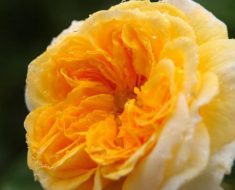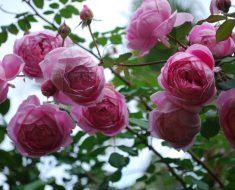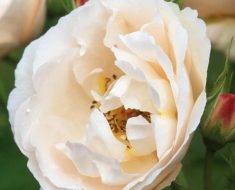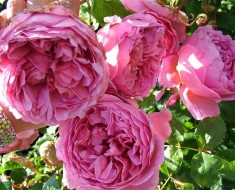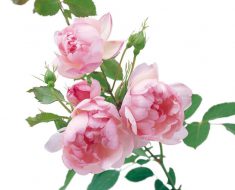Among the roses there are varieties that are clearly attributed to a particular group is difficult. Their growth characteristics vary in different climatic zones. In warm climates, they grow more intensely, and in colder areas – on the contrary, they do not gain altitude. For example, rose Amulett. These roses are commonly called modern flower beds, which means that they can be used in the design of the site in various types of flower-leafy compositions in open ground, as well as in container gardening.
Specifications of rose Amulette
Modern flowerbed Amulett from Tantau has such features. In Germany, where it was bred in 1991, it is a low-growing plant, not more than 50 cm high. But in the south of Italy or in the northern countries of Africa, or in Australia, this variety of roses grows up to 1 m. Therefore, clearly classify miniature this rose, or floribunda (the type of flowering is the same) is still impossible. However, this does not have an important influence on its popularity among gardeners, landscape designers and simply amateur gardeners. The bush forms flexible straight shoots of a greenish-burgundy color. The bush is very branched. The foliage is colored dark green and glittering, healthy. The Tantau Amulett rose is endowed with powdery mildew resistance, but can be slightly affected by it, like black spot. For the winter this plant is covered. The flowering is a constant cascade, starting with the arrival of summer and ending with the onset of low temperatures. On the rose bush Amulett from Tantau, dahlia-like flowers of bright saturated pink color alternately alternate in racemes consisting of 5-20 pieces. The author Hans Jürgen Evers created a geometrically correct flower consisting of 26-40 petals arranged in regular concentric circles, even the bud is almost perfectly round. When the rose is fully open, a crown of golden stamens is visible. The size of a fully licentiated flower is 4-6 cm. In the sun, the color can lighten. There is no flavor.
Care about rose Amulette
Like all roses, the variety of roses Amulett from Tantau or TANtaluma prefers sunny areas. Grows in partial shade, but flowering is not so abundant. If you have the opportunity, plant a rose in black soil. Other types of soil will be suitable for its cultivation, but they will have to be slightly corrected, introducing non-sufficient elements, or replacing the bad ones with good ones (for example, acidity is knocked out with lime, etc.). The area for the growth of roses should be drained so that there will not be stagnation of water that adversely affect the root system of the plant.
Moisturize the soil from the Tantau Amulett rose as needed or 2 times a week with 8-10 liters of water per plant during arid time do it more often. It is advisable to water in the evening, so that during the night the soil is as deeply saturated with moisture. It is necessary to gradually give the plant life-giving moisture gradually – in small portions (the above-mentioned liters of water). Evening sprays, which also help to avoid aphids and spider mites, rosaceous tsitadok, also have a beneficial effect on the flower. Fertilizing with minerals, vitamins and organic matter makes the plant more resistant to diseases, pests and colds. If you do not feed the rose at least once every two weeks, then during the growing season the plant will not “give out all its charms with a bang” in the amount in which it can, but half as much. In winter, a weak rose is prone to frostbite, not only the upper part, but also the root system. From this it follows that there is a risk of losing half, if not the whole rose. To fertilize the soil of a plant you can pour out granules of complex top dressings around the plant, or dilute them in water and alternate with irrigations. Vitamins are best given by spraying. Apply only well rotted organic matter. As an option, this is a mulch backing from a mixture of manure and soil (1: 2). In this case, with each watering, a fresh portion of useful substances “comes up” to the plant. Cutting of floribunda roses consists of summer, winter and spring adjustments of the plant. In the summer, faded flowers and brushes, diseased parts are mostly removed. Winter pruning is the basic pruning, the meaning of which is to form a future plant, to cut out diseased, old and thickening branches. Pruning branches so that the last bud “looked out” of the bush. The spring pruning of the Tantau Amulett rose variety is done after the rose has been opened and the night temperatures have been established. Its task is to remove damaged parts of the plant during the winter time. Winter pruning is carried out in warm areas. If you find any diseases on the bush, use the appropriate drug available in your area. The same will be the advice about insects. In a drought, if there is such an opportunity, pritenite a rose – the flowers will last longer.
How to use rose Amulette
The variety of roses Amulett from Tantau is an excellent border and container plant. They should be planted at a distance of 35-40 cm from each other. Rabatka is a flower bed where a rose, together with its companions, will create an indelible impression. It can be landed on a regular French bed, and on the Italian patio, and on the ledges of the terrace or rock garden \ rockaria. Choose plants with a silvery, white, blue, violet or yellow color. For example, lavender, catnip, cineraria, bluegrass fescue, Alba Maxima rose, Ambridge Rose, Rosa brunonii, Glamis Castle, Sultry Sangria, Gold Struck, Molineux, Munstead Wood, etc., bells, irises, hosts, cloves, phlox, gladioli and etc. When creating a composition, do not use more than 6-7 different plants for a regular flower composition of small size. For mixborders allowed planting a large number of different plants. Read more in the “Fashionable mixborder do it yourself”.

